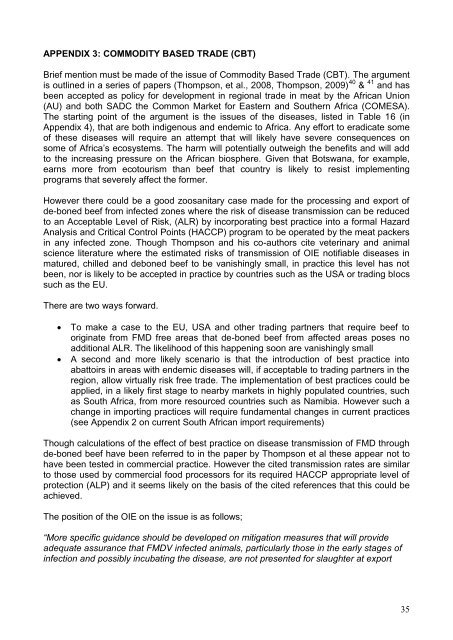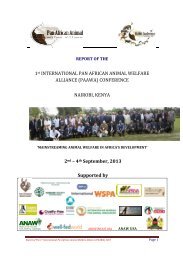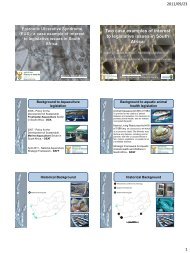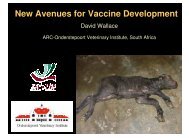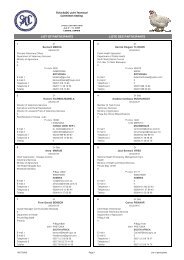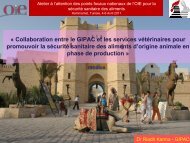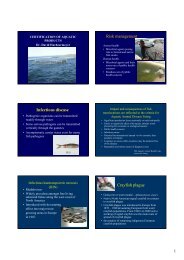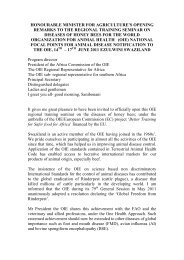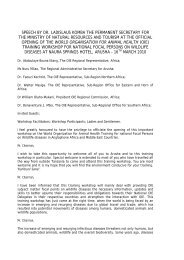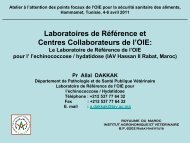Case Study: SPS Issues and Regional Trade in ... - OIE Africa
Case Study: SPS Issues and Regional Trade in ... - OIE Africa
Case Study: SPS Issues and Regional Trade in ... - OIE Africa
You also want an ePaper? Increase the reach of your titles
YUMPU automatically turns print PDFs into web optimized ePapers that Google loves.
APPENDIX 3: COMMODITY BASED TRADE (CBT)Brief mention must be made of the issue of Commodity Based <strong>Trade</strong> (CBT). The argumentis outl<strong>in</strong>ed <strong>in</strong> a series of papers (Thompson, et al., 2008, Thompson, 2009) 40 & 41 <strong>and</strong> hasbeen accepted as policy for development <strong>in</strong> regional trade <strong>in</strong> meat by the <strong>Africa</strong>n Union(AU) <strong>and</strong> both SADC the Common Market for Eastern <strong>and</strong> Southern <strong>Africa</strong> (COMESA).The start<strong>in</strong>g po<strong>in</strong>t of the argument is the issues of the diseases, listed <strong>in</strong> Table 16 (<strong>in</strong>Appendix 4), that are both <strong>in</strong>digenous <strong>and</strong> endemic to <strong>Africa</strong>. Any effort to eradicate someof these diseases will require an attempt that will likely have severe consequences onsome of <strong>Africa</strong>‟s ecosystems. The harm will potentially outweigh the benefits <strong>and</strong> will addto the <strong>in</strong>creas<strong>in</strong>g pressure on the <strong>Africa</strong>n biosphere. Given that Botswana, for example,earns more from ecotourism than beef that country is likely to resist implement<strong>in</strong>gprograms that severely affect the former.However there could be a good zoosanitary case made for the process<strong>in</strong>g <strong>and</strong> export ofde-boned beef from <strong>in</strong>fected zones where the risk of disease transmission can be reducedto an Acceptable Level of Risk, (ALR) by <strong>in</strong>corporat<strong>in</strong>g best practice <strong>in</strong>to a formal HazardAnalysis <strong>and</strong> Critical Control Po<strong>in</strong>ts (HACCP) program to be operated by the meat packers<strong>in</strong> any <strong>in</strong>fected zone. Though Thompson <strong>and</strong> his co-authors cite veter<strong>in</strong>ary <strong>and</strong> animalscience literature where the estimated risks of transmission of <strong>OIE</strong> notifiable diseases <strong>in</strong>matured, chilled <strong>and</strong> deboned beef to be vanish<strong>in</strong>gly small, <strong>in</strong> practice this level has notbeen, nor is likely to be accepted <strong>in</strong> practice by countries such as the USA or trad<strong>in</strong>g blocssuch as the EU.There are two ways forward.To make a case to the EU, USA <strong>and</strong> other trad<strong>in</strong>g partners that require beef toorig<strong>in</strong>ate from FMD free areas that de-boned beef from affected areas poses noadditional ALR. The likelihood of this happen<strong>in</strong>g soon are vanish<strong>in</strong>gly smallA second <strong>and</strong> more likely scenario is that the <strong>in</strong>troduction of best practice <strong>in</strong>toabattoirs <strong>in</strong> areas with endemic diseases will, if acceptable to trad<strong>in</strong>g partners <strong>in</strong> theregion, allow virtually risk free trade. The implementation of best practices could beapplied, <strong>in</strong> a likely first stage to nearby markets <strong>in</strong> highly populated countries, suchas South <strong>Africa</strong>, from more resourced countries such as Namibia. However such achange <strong>in</strong> import<strong>in</strong>g practices will require fundamental changes <strong>in</strong> current practices(see Appendix 2 on current South <strong>Africa</strong>n import requirements)Though calculations of the effect of best practice on disease transmission of FMD throughde-boned beef have been referred to <strong>in</strong> the paper by Thompson et al these appear not tohave been tested <strong>in</strong> commercial practice. However the cited transmission rates are similarto those used by commercial food processors for its required HACCP appropriate level ofprotection (ALP) <strong>and</strong> it seems likely on the basis of the cited references that this could beachieved.The position of the <strong>OIE</strong> on the issue is as follows;“More specific guidance should be developed on mitigation measures that will provideadequate assurance that FMDV <strong>in</strong>fected animals, particularly those <strong>in</strong> the early stages of<strong>in</strong>fection <strong>and</strong> possibly <strong>in</strong>cubat<strong>in</strong>g the disease, are not presented for slaughter at export35


